Juanma Lillo’s article for The Athletic shortly after the Qatar World Cup marked a turning point in football. From a philosophical perspective, the former Pep Guardiola and Man City assistant questioned the very approach that made him a household name in football. Using the World Cup as his case study, Lillo highlighted today’s football loss for emotion, for nature.
Lillo expressed his contempt for the oversaturated world of analysis, where there must always be a why, a reason behind every result. In his words, after 30 years in football, the “only thing [he is] certain of is uncertainty”. The former La Liga manager continues by using the popular obsession with two touches as a symbol for individual repression before finally questioning, “Who am I to take them away from a life of learning as rich and valuable as they have, with their excitement and joy to play?”.
Juanma finishes by remembering Socrates, the philosopher. Lillo claims to believe teaching does not exist, only learning. Similar to Socrates, his approach is now one of a professor who does not teach, but rather stimulates knowledge by walking alongside his students and asking questions.
Lillo’s words and change in perspective represent a broader philosophical revolution in football. The meticulous scientific approach which has dominated football in recent years may be reaching a plateau, a stalemate. The answer? Well if recent trends indicate anything, it is a return to the individual, to the spontaneous.
After taking charge of Qatar’s Al Sadd in the middle of 2022, Juanma Lillo has been experimenting with a new approach. This style of football can be very much linked to the likes of Fernando Diniz and Luciano Spalletti. In the online world, this new philosophy has been labelled as Functional Play, which is what we will use in this article.
This tactical analysis will examine Juanma Lillo’s tactics at Al Sadd, and how the 57-year-old is playing a key role in a broader philosophical revolution. Focusing on his side’s behaviour in possession, this analysis will identify how exactly this philosophical approach translates to his newfound tactics on the pitch.
Formless
The first significant change begins with the structure or lack thereof. In this approach, there is significant positional freedom for the individual. This is best described as a positional spectrum rather than a non-negotiable rule. Obviously, there can be extreme cases, where teams in possession may not have any predetermined structures whatsoever. However, you can slide across the spectrum and have more of a balance between a defined structure and more spontaneous movements.
At any rate, in recent games, Juanma Lillo’s Al Sadd is very much characterised by a lack of predetermined structures. Players like Akram Afif and former Arsenal midfielder Santi Cazorla are free to roam and negotiate with spaces as they see fit.
Juanma has varied between numerous formations in recent matches, but there are still some consistent characteristics relating to the distribution of players throughout the pitch. The map below illustrates Al Sadd’s average positions in a match.
Some notable features can be immediately seen, such as an asymmetrical shape, focus and liberty in the central channels, and a lack of width on the left wing. These features are all direct consequences of his players’ characteristics, which as Lillo expressed, are now the guiding factor in the forming of his collective.
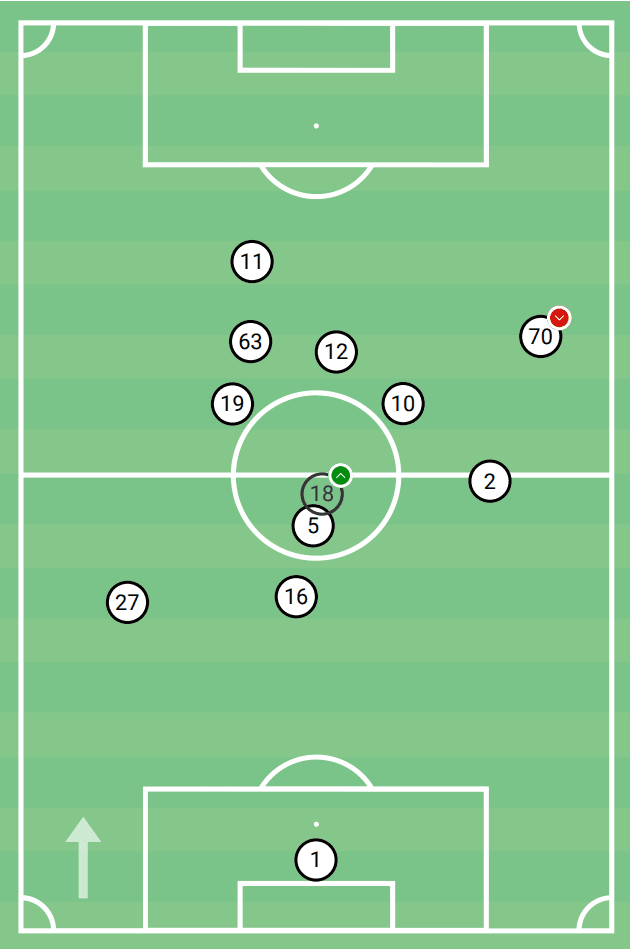
Before moving on, this functional approach to the structure can lead to some misconceptions, such as that the manager has no say in the team’s attacking system. This is far from the truth, and there is a better way of looking at this.
The manager must be nowhere yet everywhere at the same time. He is responsible for creating an environment where the players understand each other on the pitch and blend into one. He is responsible for stimulating the individual and their contribution to the side. The focus is now on integrating the individual into the collective, not the collective into the individual.
A familiar build-up
Curiously, the team’s behaviour in the first phase of possession is an expansive one, where the width and the playing area are maximised. This is only used in the build-up, and as the team settles into possession in the opposition half, a distinct and more functional approach is used.
This is not a significant part of Lillo’s possession system. The league’s average PPDA is 10.06, and aside from the bigger sides, teams rarely adopt a notable high press. Nonetheless, this early phase can already display some features of their possession.
In this example, the initial structure is an expansive 3-5-2, as highlighted below. The left wing-back is Santi Cazorla, and he can be seen coming inside much more than the right wing-back.
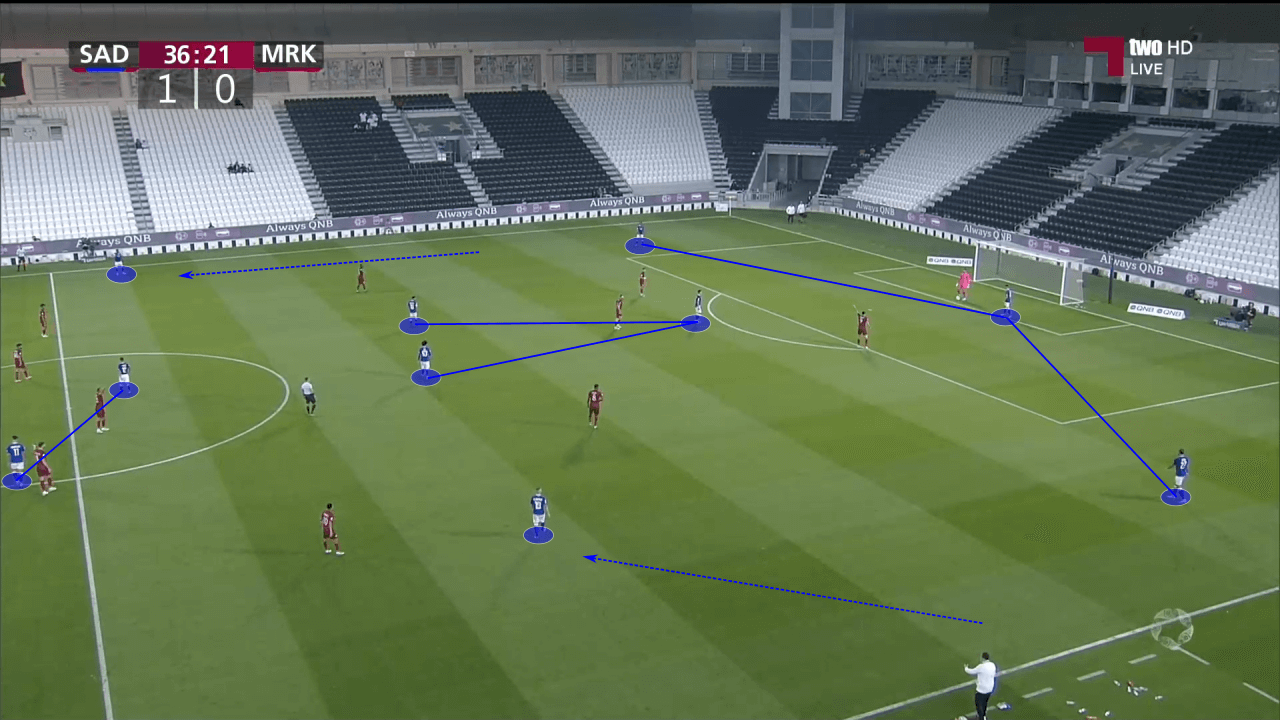
As we will examine later, their strategy revolves around engaging the opposition. This can be done through many principles and subprinciples. One of the more common ones is attracting and switching.
Highlighted below, Al Sadd engages the opposition on the right wing before quickly playing away from pressure. One of the obvious advantages of this is the overload it creates on a specific zone and the subsequent space and vulnerability on the opposite side. Other effects include demanding significant effort and movement from the opposition, which can lead to fatigue and lapses of focus as the match goes on.
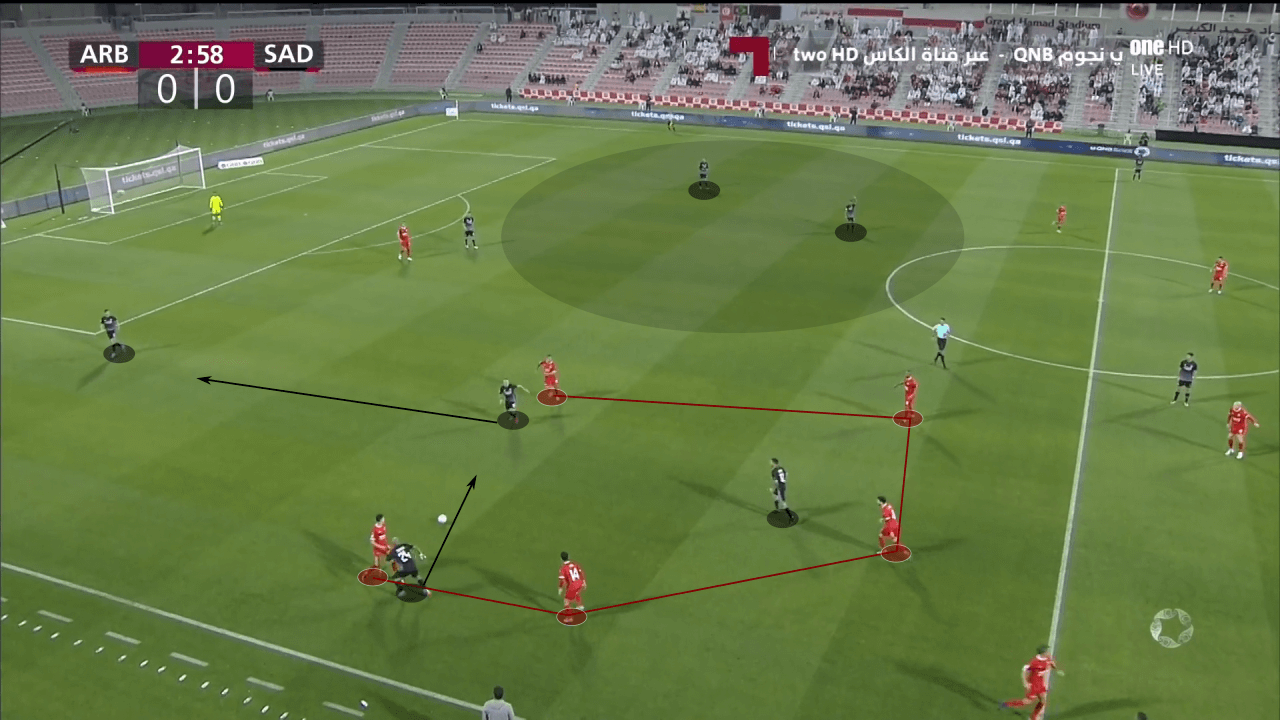
Another way through which Al Sadd engage the opposition is through slow switches. While they do perform long switches, they often like to switch the ball to the other side through shorter lateral passes, as seen below. This requires the defence to engage as they laterally shift their block, which can create holes and channels to explore.
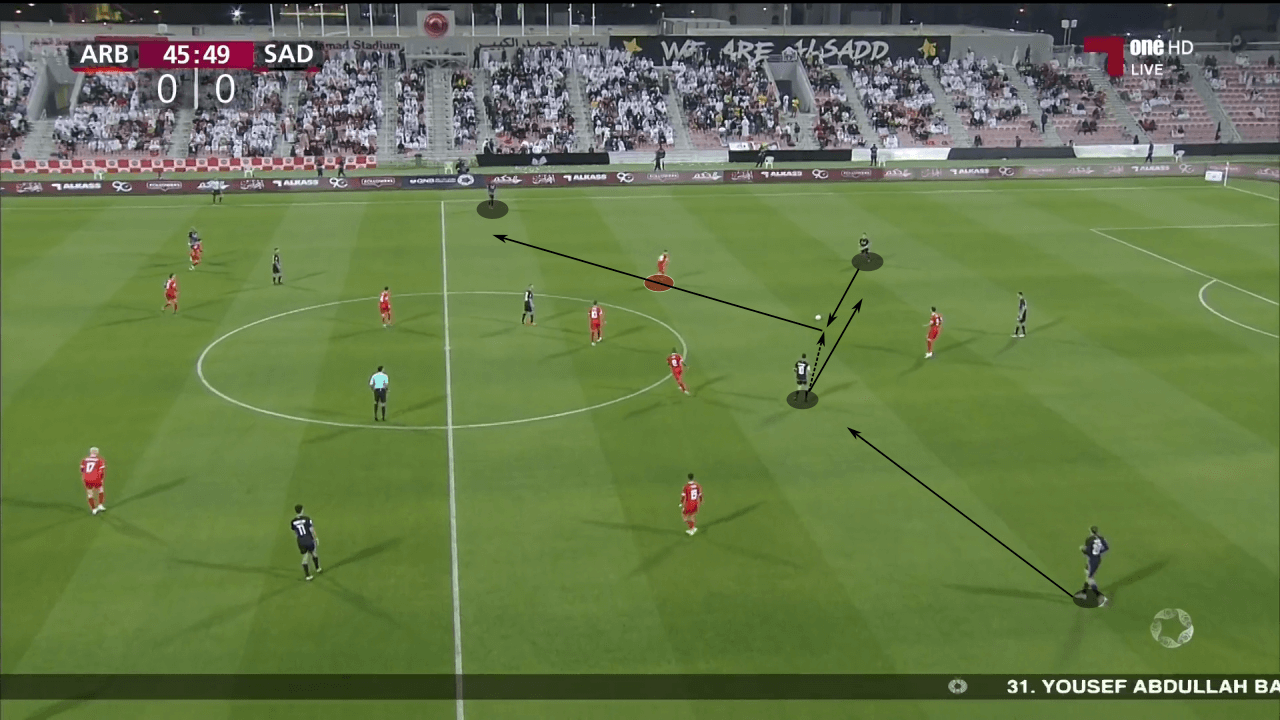
Functional attack
Now, we can move on to their work in the later stages of possession, where significant change can be seen. This style of attack has many dimensions, which all stem back to this new philosophical approach Lillo is taking. The best way to start is by examining how they look with the ball.
As they attempt to break into the final third, Al Sadd’s distribution of players is unusual. It begins with the asymmetrical behaviour of the wing-backs. When Cazorla significantly shifts inside, there is little effort to maintain that width and depth on the left wing. On the contrary, the focus is on the central areas, where players are freely roaming the spaces.
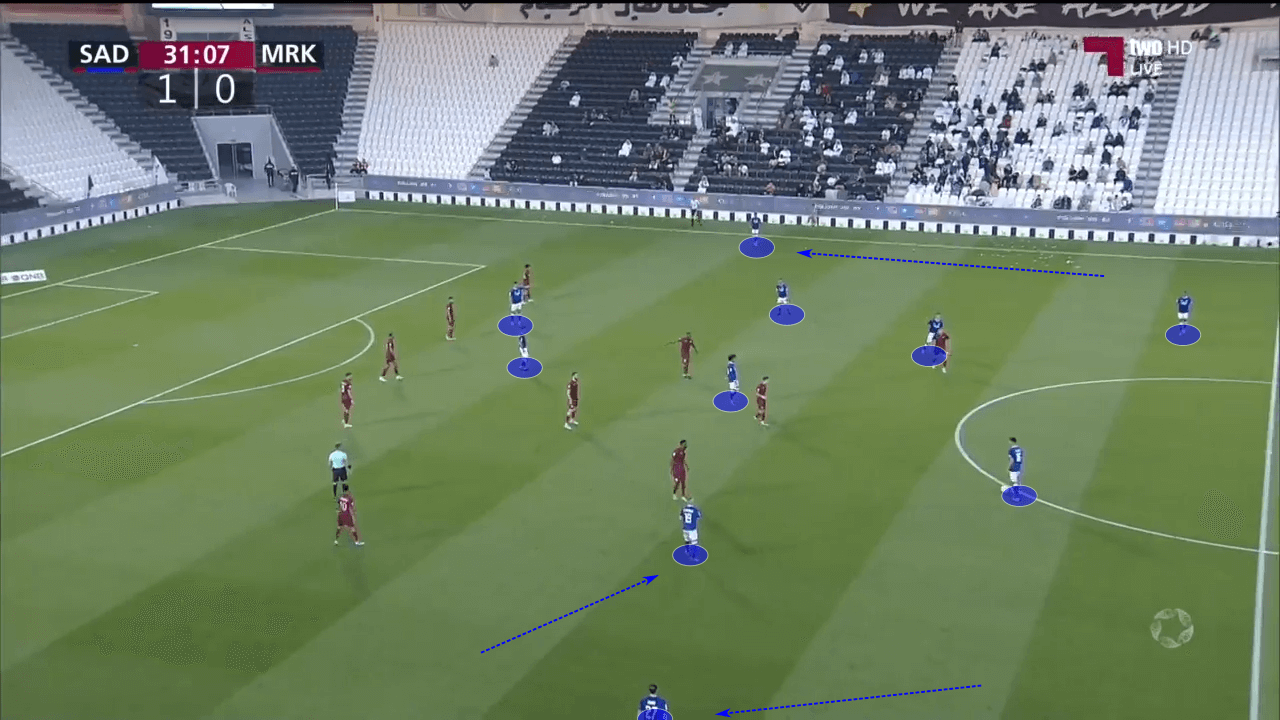
Later in the match, we can see this fluidity in full effect. The players are in different positions than before, but the focus and concentration are still on approximation and overloads. The centre-froward, highlighted by the arrow, drops much deeper while Afif now explores the backline.
There is a total of seven players between the left half-space and the central channel, something almost forbidden in positional play. The priority is no longer a rational occupation of spaces throughout the pitch, but rather the natural relationship among players, which is enhanced by proximity.
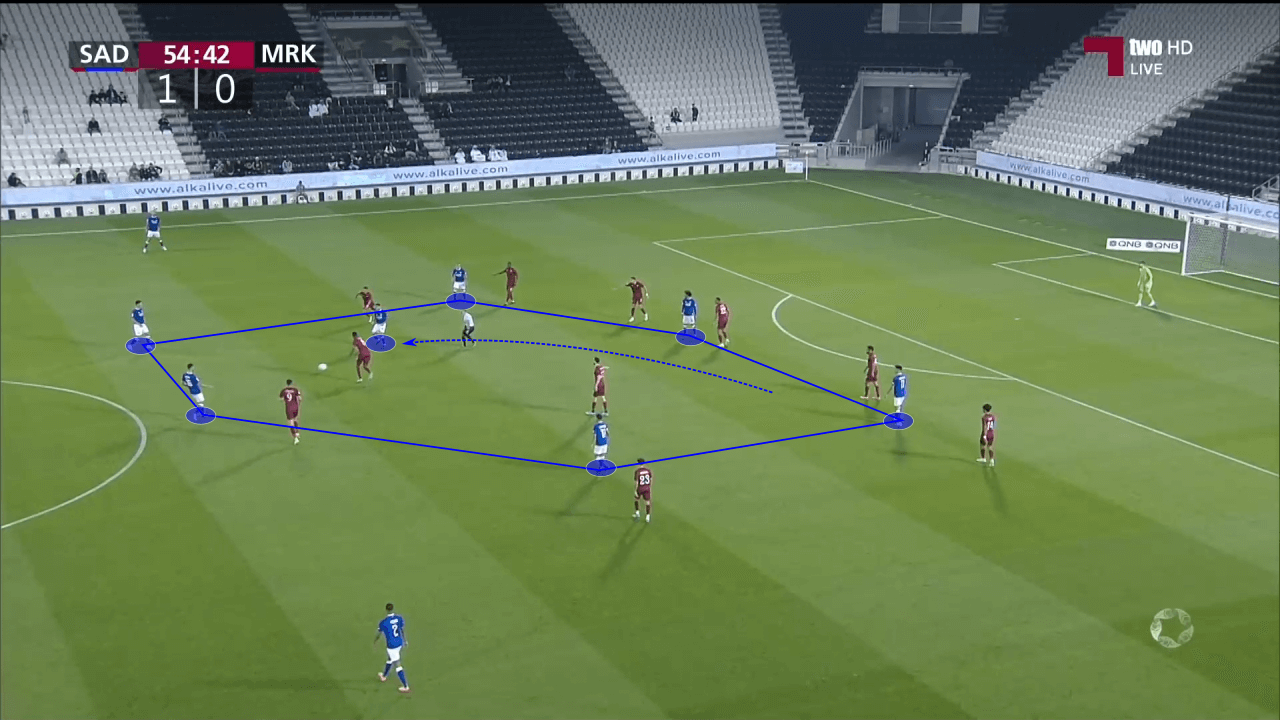
In another instance, we can see the same trend, now focused on the left side of the pitch. Again, the centre-forward freely roams into the midfield and provides support to possession. In addition, four other players are positioned near the ball carrier.
A common trend in Functional Play is the constant creation of passing lanes around the ball. Players are free to move in and out of spaces, creating passing lanes before moving again. Once more, this is done through approximation, and its spontaneous nature further indicates liberty in positioning.
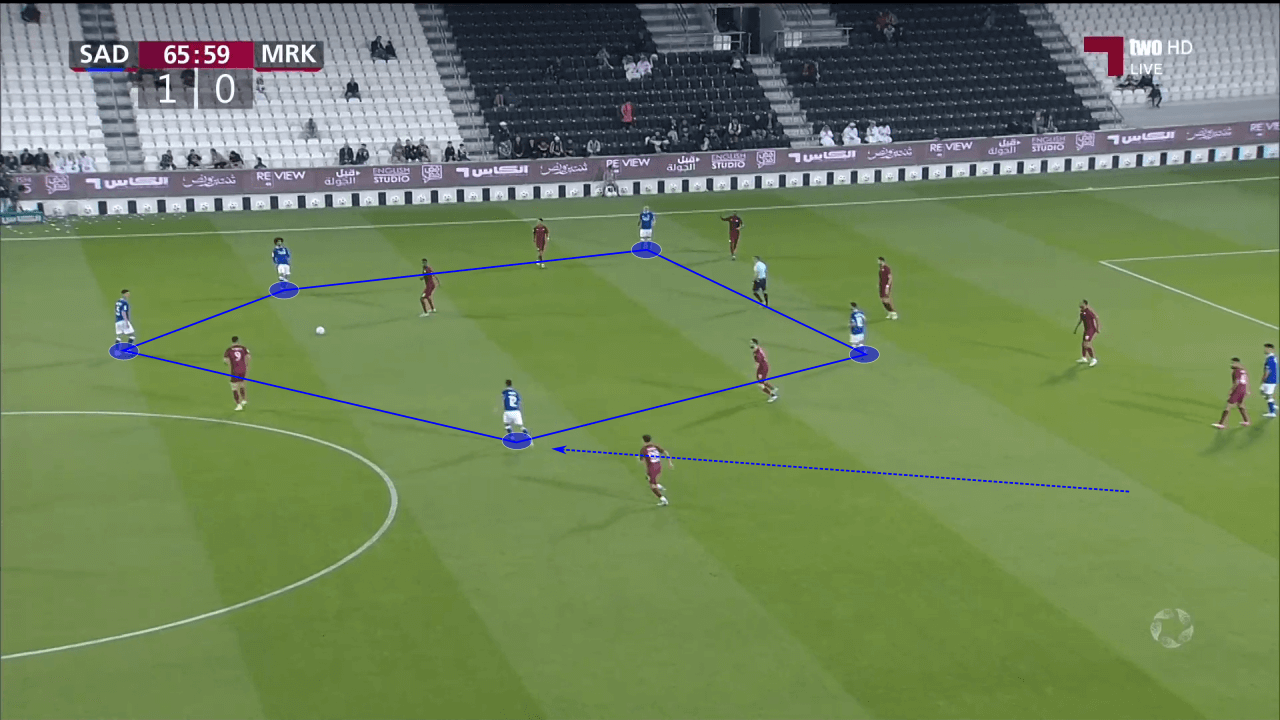
Only two minutes before the instance above, we can see exactly zero players occupying the left wing in possession. This helps us understand this system a bit more. While the average positions and initial shape indicate central overloads, there is no restriction.
If possession takes them out wide, the players are free to support that zone and collectively progress there. If they wish to remain central and combine through the middle, they are also free to do so.
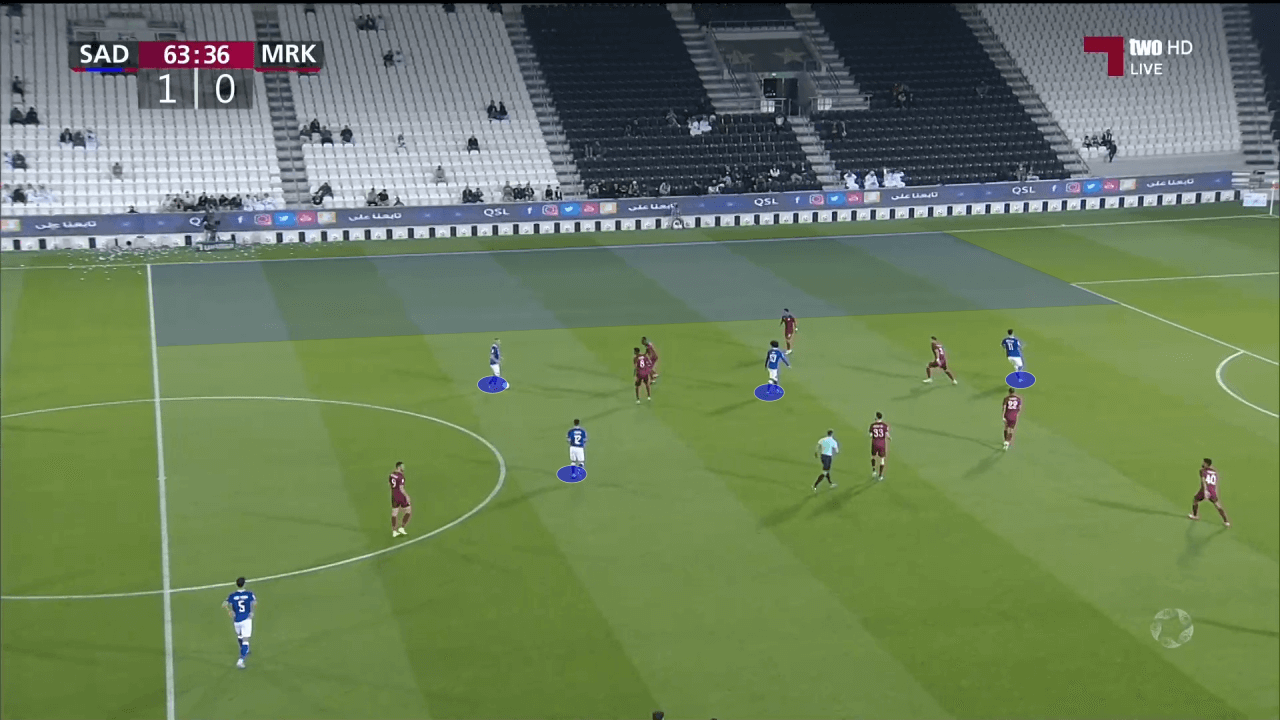
Possession as a conversation
As we briefly explored in the build-up phase, their behaviour with the ball is around the idea of engaging the opposition. With 62.02% average possession, it is clear Lillo’s side is quite possession-based. However, possession is merely a resource used to carry out their ideas. With the ball, they demand the opposition to act before they react.
In this first instance, we can see a total of five players on the left wing. In this same area, there are seven opposition players. With their behaviour, they initially lure the opposition into shifting a significant part of their block here. With an underlapping run, they quickly exploit this by playing into the space left by the defenders.
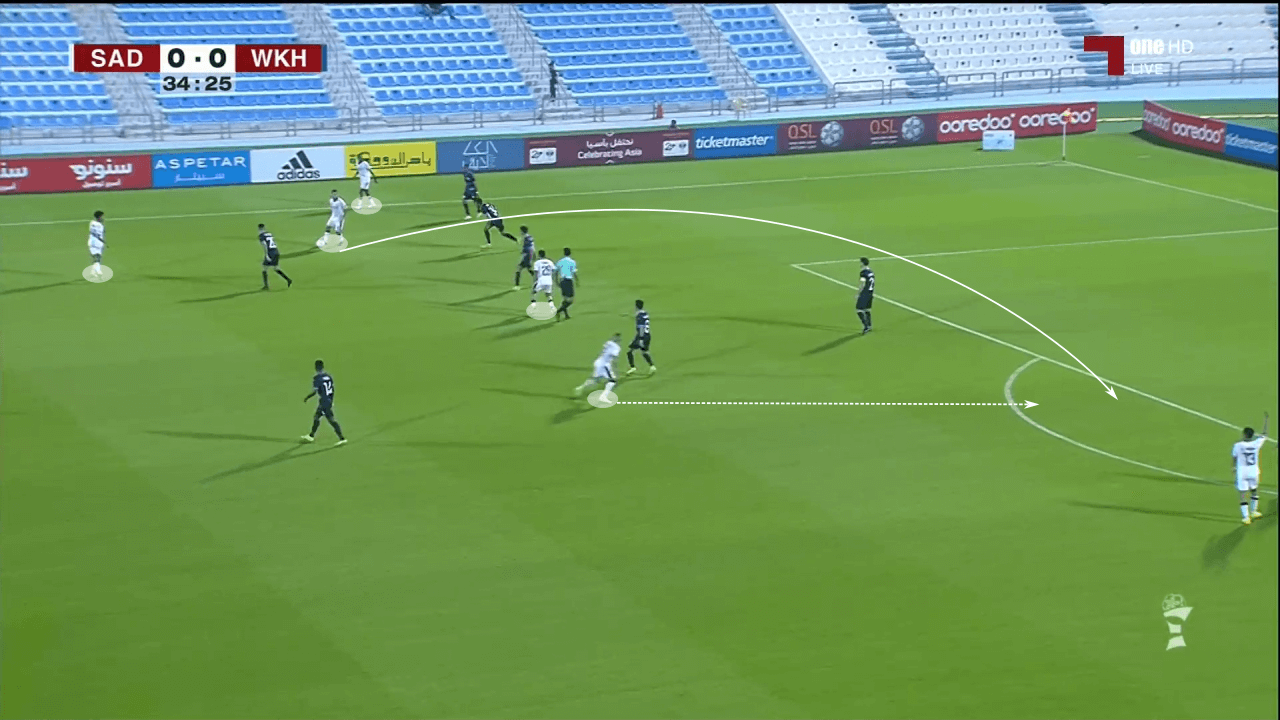
Later on in the same match, we can see a very similar scenario. As they progress across the middle third, they focus their players on the right-hand side. To deal with such a high number of players, the opposition naturally shifts their block over. By doing this, they leave significant space on the opposite side, which is quickly exploited.
Approaching possession with symmetry and maximum width from the beginning would have seen the opposition stretch their block. Although this could have led to larger spaces to play through, it certainly would not have created dangerous scenarios such as the one below.
Rather than a static and slow ball progression, this approach can create more exciting and spontaneous moments like this.
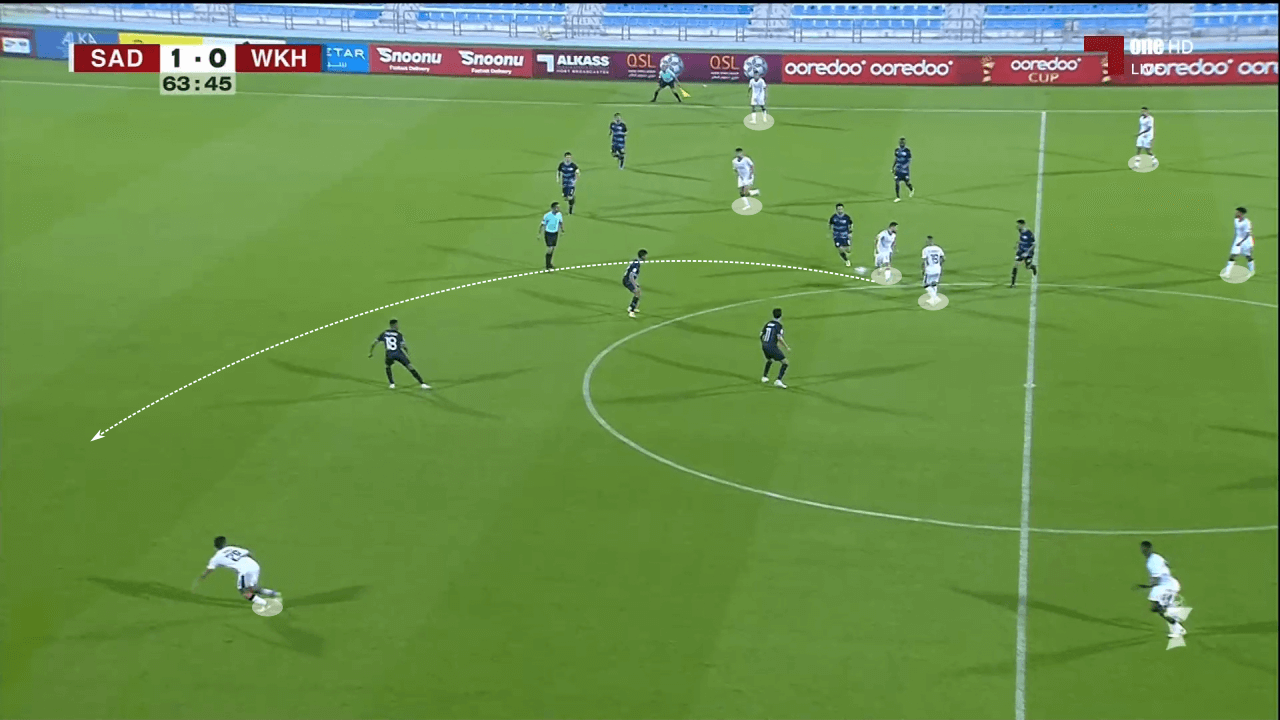
In a different setting, a similar tendency can be seen. Al Sadd attract five defenders around the ball before switching and exploring the other side. Although this is a less extreme example, the idea of engaging and demanding from the opposition with their passing is still there.
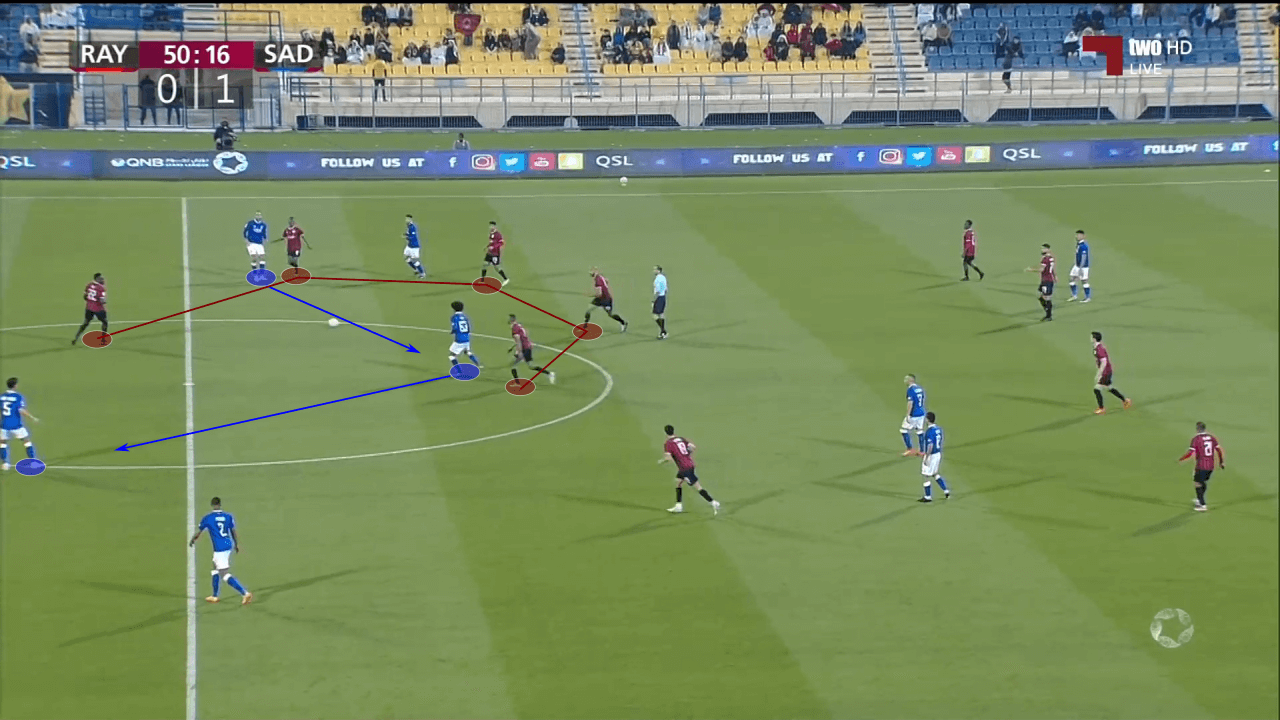
Finally, slow switches can be illustrated yet again. Rather than one big switch, which can still happen, Lillo instructs his men to switch with shorter and more feet-to-feet passing. At times, long switches can be easier to defend as the defensive block shifts while the ball is in the air. In this approach, however, the defence is required to engage with each pass as they try to shift over. This can create desirable scenarios and gaps to exploit.
Again, the idea of playing with the opposition is there. Lillo’s possession forces the opposition to act and his players to react.
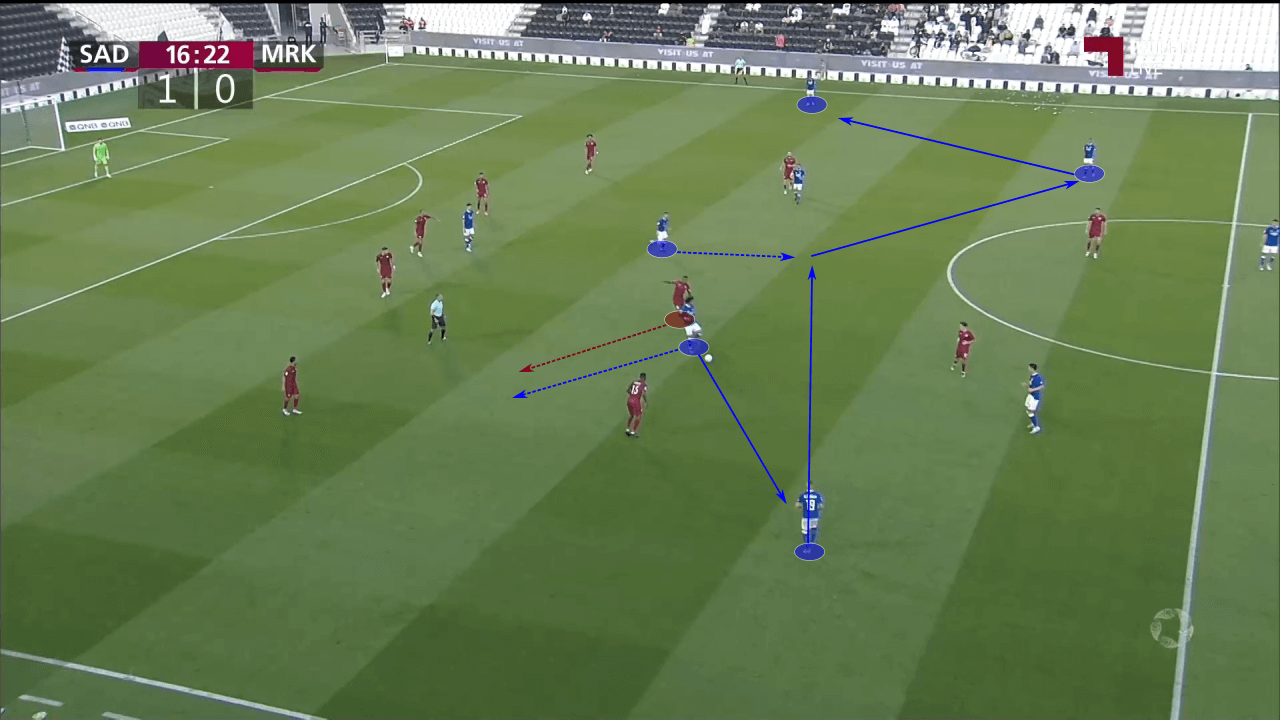
Conclusion
With his article for The Athletic and his work in Qatar, Juanma Lillo has displayed a significant change in perspective, specifically in his philosophical approach to football. This philosophical shift has been taking place in other corners of the world as well, and it is led by the growing Functional Play. This style of play is the means through which this new philosophical approach meets in-game tactics.
As we explored in this analysis, Lillo’s Al Sadd displays some of the cornerstones of this new tactical approach. As it grows in popularity, it will be very interesting to see how this style develops. However, it is clear that, once again, Juanma Lillo will play a key role in the development of a new tactical era.





Comments